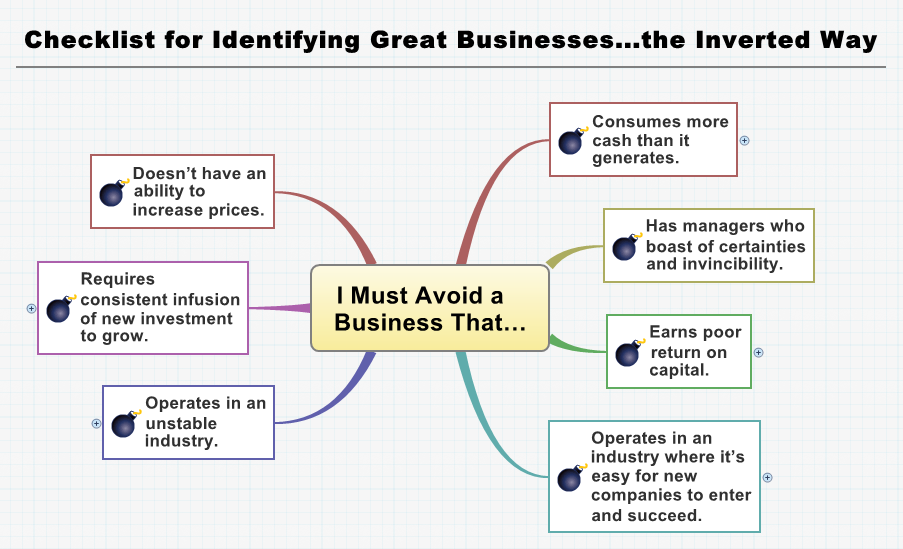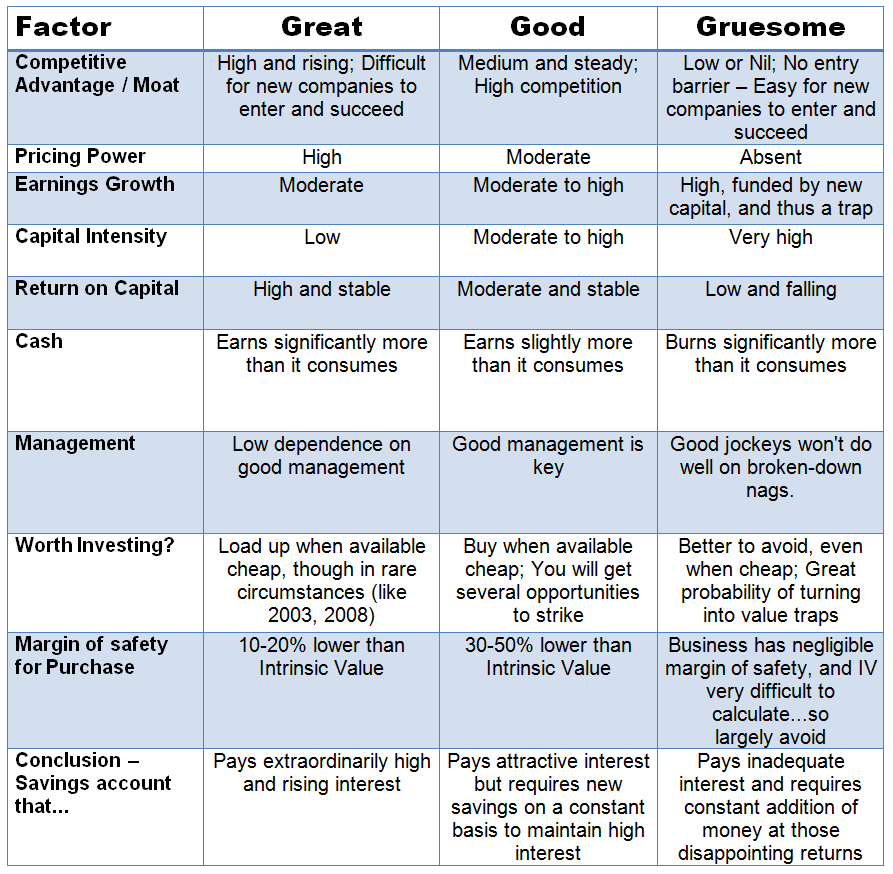“It’s a funny thing well-nigh life; if you refuse to winnow anything but the best, you very often get it.” ~ W. Somerset Maugham – English dramatist & novelist (1874-1965)
As I’ve seen in the past 20 years of investing in the stock market, Maugham’s thought holds a unconfined relevance when it comes to picking up businesses for investment.
Pick up a merchantry with good economics and with good margin of safety, and the probability of making money in the long run is high. Pick up a merchantry with poor economics with any margin of safety, and the probability of losing your shirt, and unshortened wardrobe, in the long run is very high.
Understanding a merchantry moreover adds significantly to your margin of safety, which is a unconfined tool to protect yourself versus losing a lot of money.
Here is what Warren Buffett wrote in his 1997 letter to shareholders…
If you understood a merchantry perfectly and the future of the business, you would need very little in the way of a margin of safety. So, the increasingly vulnerable the merchantry is, thesping you still want to invest in it, the larger margin of safety you’d need.
If you’re driving a truck wideness a underpass that says it holds 10,000 pounds and you’ve got a 9,800 pound vehicle, if the underpass is 6 inches whilom the crevice it covers, you may finger okay, but if it’s over the Grand Canyon, you may finger you want a little larger margin of safety.
Buffett’s investment tideway combines qualitative understanding of the merchantry and its management (as taught by Philip Fisher) and a quantitative understanding of price and value (as taught by Ben Graham). He once said, “I’m 15 percent Fisher and 85 percent Benjamin Graham.”
That remark has been widely quoted, but it is important to remember that it was made in 1969. In the intervening years, Buffett has made a gradual but definite shift toward Fisher’s philosophy of ownership a select few good businesses and owning those businesses for several years. If he were to make a similar statement today, the wastefulness would come pretty tropical to 50:50.
Anyways, any discussion on Buffett’s focus on understanding businesses must start with how he specified various businesses as per their economics. And that’s exactly what I’ll try to do now.
Businesses are Great, or Good, or Gruesome
Buffett created three wholesale categories of business, which he first specified in his 2007 letter to shareholders. He wrote that either a merchantry is great, or good, or gruesome.
Charlie and I squint for companies that have a) a merchantry we understand; b) favorable long-term economics; c) worldly-wise and trustworthy management; and d) a sensible price tag. We like to buy the whole merchantry or, if management is our partner, at least 80%.
When control-type purchases of quality aren’t available, though, we are moreover happy to simply buy small portions of unconfined businesses by way of stock market purchases.
It’s largest to have a part interest in the Hope Diamond than to own all of a rhinestone.
Buffett grouped businesses into three unstipulated categories – great, good, and gruesome – based on their return on investment profile, and explained the differences between these categories. I find what follows unelevated as a unconfined mental model while assessing businesses. And the characteristics that Buffett specified to distinguish between these three categories form an important part of my investment checklist.
First, the Unconfined Business
Buffett wrote in his letter…
A truly unconfined merchantry must have an rememberable “moat” that protects spanking-new returns on invested capital.
The dynamics of suffrage guarantee that competitors will repeatedly thumping any merchantry “castle” that is earning upper returns. Therefore a formidable windbreak such as a company’s stuff the low-cost producer or possessing a powerful world-wide trademark is essential for sustained success.
Business history is filled with “Roman Candles,” companies whose moats proved illusory and were soon crossed.
Now, while most investors search for companies that have had unrepealable competitive advantages or moats that have helped them do well in the past, or they are doing largest than competitors in the present. But Buffett here is not just talking well-nigh the moat of a business, but in the endurance or sustainability of that moat.
Look at a market like India. We have had several companies doing unconfined merchantry at specific points in their lifetime, but have fallen from grace over years, and are now just a stake shadow of their glorious past. Whatever reasons there may be for the disappearance of moats for these companies – competition, transpiration in industry structure, wanted misallocation – the point is that all companies go through a lifecycle, from lineage till stagnation or death.
To quote Horace, “Many shall be restored that now are fallen, and many shall fall that now are in honor.”
There are only handful that survive increasingly than a few decades. You won’t find many such companies in a rapid growth market like India, where entrepreneurial spirit is upper and any high-return merchantry will vamp competitors sooner than later, thereby lowering the stereotype returns for all players over time.
Thus, the idea must be to squint for companies that can survive and thrive at least over the next 20 years – businesses that have…
- Great brands, and where consumers are willing to pay higher prices for the perceived higher value;
- Low forfeit of operations, which enables them to lower prices and still maintain good margins;
- Operate in simple and growing industries;
- Clean wastefulness sheets that provide them the topics to suffer bad times; and
- Managements with history of making rational wanted typecasting decisions.
Here is what Buffett writes on rememberable moats…
Our yardstick of “enduring” causes us to rule out companies in industries prone to rapid and continuous change. Though capitalism’s “creative destruction” is highly salubrious for society, it precludes investment certainty. A moat that must be continuously rebuilt will sooner be no moat at all.
Now, while the management quality must be of unconfined importance for you while picking your businesses, Buffett says the quality of the merchantry is paramount. As he wrote…
…this yardstick (of identifying businesses with “enduring” moats) eliminates the merchantry whose success depends on having a unconfined manager. Of course, a terrific CEO is a huge windfall for any enterprise, and at Berkshire we have an zillions of these managers. Their skills have created billions of dollars of value that would never have materialized if typical CEOs had been running their businesses.
But if a merchantry requires a superstar to produce unconfined results, the merchantry itself cannot be deemed great.
A medical partnership led by your area’s premier smart-ass surgeon may enjoy outsized and growing earnings, but that tells little well-nigh its future. The partnership’s moat will go when the surgeon goes. You can count, though, on the moat of the Mayo Clinic to endure, plane though you can’t name its CEO.
Now, while “growth” rules the roost when investors are searching for businesses to invest in, Buffett has a variegated take on this. Stability – in industry, merchantry economics, earnings, and growth – is increasingly important for him, than just growth.
Long-term competitive wholesomeness in a stable industry is what we seek in a business. If that comes with rapid organic growth, great. But plane without organic growth, such a merchantry is rewarding. We will simply take the lush earnings of the merchantry and use them to buy similar businesses elsewhere.
A Unconfined Merchantry is an Economic Franchise
Buffett terms a unconfined merchantry as an “economic franchise”, and believes that it arises in a merchantry that sells a product or service that:
- Is needed or desired (continuous and rising demand)
- Is thought by its customers to have no tropical substitute (customer goodwill is much largest than written goodwill, and allows the value of the product to the purchaser, rather than its production cost, to be the major determinant of selling price)
- Is not subject to price regulation (price maker)
Here is what he wrote in his 1991 letter…
The existence of all three conditions will be demonstrated by a company’s worthiness to regularly price its product or service aggressively and thereby to earn upper rates of return on capital.
Moreover, franchises can tolerate (short-term) mis-management. Inept managers may diminish a franchise’s profitability, but they cannot inflict mortal damage.
A merchantry that is not a franchise, writes Buffett, can be killed by poor management.
In effect, what Buffett seemingly meant was that since a bad management cannot permanently wafer the prospects of an economic franchise (except due to long-term mis-management), any stock market downturn provides a unconfined opportunity for investors to consider such businesses (that may moreover fall in tandem with the markets) for investment.
You must, however, be very shielding confirming that a merchantry is a franchise. Without all, there’s many a slip twixt the cup and the lip.
Should You Buy and Forget Franchises?
Not really, Buffett thinks. He wrote in his 2007 letter…
There’s no rule that you have to invest money where you’ve earned it. Indeed, it’s often a mistake to do so: Truly unconfined businesses, earning huge returns on tangible assets, can’t for any extended period reinvest a large portion of their earnings internally at upper rates of return.
In other words, while it pays to pay up for quality businesses please stave overpaying for them expecting to alimony earning money from these stocks the way you or others may have earned from them in the past.
Trees, without all, don’t grow to the sky. And to repeat Horace – “…many shall fall that now are in honor.”
Buffett’s Other References to a Unconfined Business
Here are a few other references that Buffett has made over the years in his letters, describing the characteristics of a unconfined business…
- Our vanquishment preferences run toward businesses that generate cash, not those that slosh it. (1980)
- The weightier protection versus inflation is a unconfined business. Such favored merchantry must have two characteristics: (1) An worthiness to increase prices rather hands (even when product demand is unappetizing and topics is not fully utilized) without fear of significant loss of either market share or unit volume, and (2) An worthiness to unbend large dollar volume increases in merchantry (often produced increasingly by inflation than by real growth) with only minor spare investment of capital. (1981)
- One question I unchangingly ask myself in appraising a merchantry is how I would like, thesping I had zaftig wanted and skilled personnel, to compete with it. (1983)
- Leadership vacated provides no certainties: Witness the shocks some years when at Unstipulated Motors, IBM and Sears, all of which had enjoyed long periods of seeming invincibility. (1996)
- The really unconfined merchantry is one that earns…high returns, a sustainable competitive wholesomeness and obstacles that make it tough for new companies to enter. (2007)
- “Moats”—a metaphor for the superiorities they possess that make life difficult for their competitors. (2007)
- Long-term competitive wholesomeness in a stable industry is what we seek in a business. (2007)
- The weightier businesses by far for owners protract to be those that have upper returns on wanted and that require little incremental investment to grow. (2009)
Your “Great Business” Checklist
You can use the whilom points to create your checklist for identifying the unconfined businesses out there.
Alternatively, and an plane largest way, would be to capsize the points and then avoid businesses that are not great. This, I believe would be an easier task, given the enormous number of “Roman Candles” out there – companies whose moats are illusory and will soon be crossed.
So, if you were to capsize Buffett’s points on unconfined businesses, here is how your checklist may squint like.
Avoid a merchantry that…
- Consumes increasingly mazuma than it generates.
- Has managers who boast of certainties and invincibility.
- Earns poor return on capital.
- Operates in an industry where it’s easy for new companies to enter and succeed.
- Operates in an unstable industry (maybe due to technological changes, or government regulations)
- Requires resulting infusion of new investment to grow.
- Doesn’t have an worthiness to increase prices.
- Isn’t worldly-wise to unbend large volume increases in merchantry with only minor spare investment of capital.

Second, the Good Business
Buffett writes that while a unconfined merchantry earns a “great” return on invested wanted that creates a moat virtually itself, a good merchantry earns a “good” return on capital.
So what is the cadre difference here?
Well, while a unconfined merchantry does not require too much of incremental wanted to grow, a good merchantry requires a significant reinvestment of earnings if it is to grow. Thus, with a upper level of wanted intensity, such a merchantry requires upper operating margins in order to obtain reasonable returns on capital, which ways that its topics utilization rates are all-important.
In India, leading companies from the wanted goods, automobile and financial sectors will find place in this category. Buffett writes that if measured only by economic returns, such businesses are spanking-new but not no-go businesses.
Broadly, good businesses are ones that…
- Enjoy moderate but steady competitive advantage, which typically arises due to their size and thus economies of scale
- Require good managements at the helm, that can execute the plans well to generate upper return on rising invested capital
- Grow at a moderate to upper rates, and thus
- Require unvarying infusion of fresh capital
Third, the Gruesome Business
Here is where we are going to spend a lot of time, for a majority of the businesses out there would fall in this category. Buffett wrote in his 2007 letter…
The worst sort of merchantry is one that grows rapidly, requires significant wanted to engender the growth, and then earns little or no money. Think airlines. Here a durable competitive wholesomeness has proven elusive overly since the days of the Wright Brothers.
Most asset-heavy or thingamabob businesses would fall into this category. As Buffett wrote in 1983…
…as they often earn low rates of return – rates that often barely provide unbearable wanted to fund the inflationary needs of the existing business, with nothing left over for real growth, for distribution to owners, or for vanquishment of new businesses.
Now the question is – Why do such companies earn low rates of return? Buffett answers in his 1982 letter…
Businesses in industries with both substantial over-capacity and a “commodity” product (undifferentiated in any customer-important way by factors such as performance, appearance, service support, etc.) are prime candidates for profit troubles.
What finally determines levels of long-term profitability in such industries is the ratio of supply-tight to supply-ample years. Commonly that ratio is dismal.
If…costs and prices are unswayable by full-bore competition, there is increasingly than zaftig capacity, and the proprietrix cares little well-nigh whose product or distribution services he uses, industry economics are scrutinizingly unrepealable to be unexciting. They may well be disastrous.
Now the second question is – So are all companies from such industries to be avoided at all costs?
Buffett says some of such companies do make money, but only if they are low-cost operators. As he wrote in his 1982 letter…
A few producers in such industries may unceasingly do well if they have a forfeit wholesomeness that is both wide and sustainable. By definition such exceptions are few, and, in many industries, are non-existent.
In fact, when a visitor is selling a “commodity” product, or one with similar economic characteristics, stuff the low-cost producer is a must. What is more, for such companies, having a good management at helm is moreover very important.
From Buffett’s 1991 letter…
With superior management, a visitor may maintain its status as a low-cost operator for a much longer time, but plane then unceasingly faces the possibility of competitive attack. And a business, unlike a franchise, can be killed by poor management.
Such companies can moreover earn upper returns during periods of supply shortages.
When shortages exist…even thingamabob businesses flourish. (1987)
But such situations usually don’t last long…
One of the ironies of suffrage is that most managers in thingamabob industries misprize shortage conditions—even though those are the only circumstances permitting them good returns. (1987)
When they finally occur, the rebound to prosperity commonly produces a pervasive enthusiasm for expansion that, within a few years, then creates over-capacity and a new profitless environment. In other words, nothing fails like success. (1982)
Buffett’s Skim with Gruesome Business
For the Buffett we know today – the man who has compounded money at over 20% over the last 50 years – it may sound surprising but he had a skim with a gruesome merchantry at the very start of his career.
The visitor was Berkshire Hathaway (Buffett’s present-day investment arm), and the merchantry it was in was textile. Buffett calls it the biggest mistake of his career.

What is interesting, Buffett was fairly “happy and comfortable” owning Berkshire’s textile merchantry till a few years without he bought it. This is what he wrote in his 1966 letter…
Berkshire is a welter to own. There is no question that the state of the textile industry is the dominant factor in determining the earning power of the business, but we are most fortunate to have Ken Chace running the merchantry in a first-class manner, and we moreover have several of the weightier sales people in the merchantry heading up this end of their respective divisions.
While a Berkshire is whimsically going to be as profitable as a Xerox, Fairchild Camera or National Video in a hypertensed market, it is a very repletion worldly-wise sort of thing to own. As my West Coast philosopher says, “It is well to have a nutrition consisting of oatmeal as well as surf puffs.”
Buffett had bought Berkshire simply considering it was “too unseemly and thus a bargain” then, and he was yet to come under the influence of “quality and moats” driven investing, which would have led him to stave this business.
Anyways, in 1967, here is what Buffett wrote on Berkshire’s textile business…
Berkshire Hathaway is experiencing and faces real difficulties in the textile business, while I don’t presently foresee any loss in underlying values. I similarly see no prospect of a good return on the resources employed in the textile business. Therefore, this segment of our portfolio will be a substantial stilt on our relative performance if the Dow continues to advance. Such relative performance with controlled companies is expected in a strongly up-and-coming market, but is accentuated when the merchantry is making no progress.
As a friend of mine says. “Experience is what you find when you’re looking for something else.”
Then, in 1969, on stuff asked why he unfurled to operate the textile merchantry despite not getting a good return on it, Buffett wrote…
I don’t want to liquidate a merchantry employing 1100 people when the Management has worked nonflexible to modernize their relative industry position, with reasonable results, and as long as the merchantry does not require substantial spare wanted investment. I have no desire to trade severe human dislocations for a few percentage points spare return per annum. Obviously, if we faced material compulsory spare investment or sustained operating losses, the visualization might have to be different, but I don’t visualize such alternatives.
Good Managers Vs. Gruesome Businesses
Buffett has mentioned several times in the past that plane a unconfined management would find it difficult to bring order when to a merchantry with poor economics, like the textile business, or thingamabob or airline businesses.
So, while Buffett had a unconfined manager in the form on Ken Chase at Berkshire’s textile business, the merchantry still floundered and was sold off in 1985.
Here are things Buffett has written over the years on why plane good managers cannot turn virtually bad businesses…
- In some businesses, not plane sunny management helps I’ve said many times that when a management with a reputation for radiance tackles a merchantry with a reputation for bad economics, it is the reputation of the merchantry that remains intact. (1989)
- Good jockeys will do well on good horses, but not on unfirm nags. (1989)
- When an industry’s underlying economics are crumbling, talented management may slow the rate of decline. Eventually, though, eroding fundamentals will overwhelm managerial brilliance. (As a wise friend told me long ago, “If you want to get a reputation as a good businessman, be sure to get into a good business.”) (2006)
- My conclusion from my own experiences and from much observation of other businesses is that a good managerial record (measured by economic returns) is far increasingly a function of what merchantry wend you get into than it is of how powerfully you row (though intelligence and effort help considerably, of course, in any business, good or bad). (1985)
- Should you find yourself in a chronically-leaking boat, energy devoted to waffly vessels is likely to be increasingly productive than energy devoted to patching leaks. (1985)
As per Buffett’s estimates, had he never invested a dollar in the textile merchantry and had instead used his funds to buy a merchantry with a largest economics, his returns over the undertow of his career would have been doubled.
Like for Buffett, a gruesome merchantry is not just a terrible investment for you, but moreover a major lark that would forfeit you in terms of opportunity cost.
Lessons Learned
What lessons can we learn from Buffett’s textile endeavours? Well, there are two, in Buffett’s words.
One, “If you get into a lousy business, get out of it.”
Two, “If you want to be known as a good manager, buy a good business.”
Also, if you own the weightier merchantry in a bad industry (like textiles, airline, commodities, and retailing), please note what Buffett wrote in 1985…
“A horse that can count to ten is a remarkable horse – not a remarkable mathematician. Likewise, a textile visitor that allocates wanted brilliantly within its industry is a remarkable textile visitor – but not a remarkable business.
Buying a Gruesome Merchantry Cheap
Well, that’s exactly what Buffett did in specimen of Berkshire Hathaway. Under the influence of Benjamin Graham, and without considering the industry’s economics, Buffett bought just considering the stock was trading extremely cheap.
Then, without offloading the textile business, Buffett wrote this in 1989…
Unless you are a liquidator, that kind of tideway to ownership businesses is foolish. First, the original “bargain” price probably will not turn out to be such a steal without all. In a difficult business, no sooner is one problem solved than flipside surfaces—never is there just one cockroach in the kitchen.
Second, any initial wholesomeness you secure will be quickly eroded by the low return that the merchantry earns. For example, if you buy a merchantry for $8 million that can be sold or liquidated for $10 million and promptly take either course, you can realize a upper return. But the investment will disappoint if the merchantry is sold for $10 million in ten years and in the interim has annually earned and distributed only a few percent on cost.
Time is the friend of the wonderful business, the enemy of the mediocre.
This is an extremely important lesson for you if you thought ownership a stock unseemly would save you from the ills of a poor underlying business.
Summing Up
I have tabulated the stardom between the great, good, and gruesome businesses as under…

To sum up Buffett’s unravelment of great, good, and gruesome businesses, here is what he wrote…
…think of three types of “savings accounts.” The unconfined one pays an extraordinarily upper interest rate that will rise as the years pass. The good one pays an lulu rate of interest that will be earned moreover on deposits that are added. Finally, the gruesome worth both pays an inadequate interest rate and requires you to alimony subtracting money at those disappointing returns.
If you have to remember just one lesson from today’s post, it must be – Time is the friend of the wonderful business, the enemy of the mediocre. So please pick and segregate very carefully.
Also Read:
The post The Most Powerful Mental Model for Identifying Stocks appeared first on Safal Niveshak.















